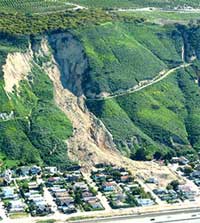Landslide Hazards Program
- Mon, 15 Dec 2008 19:47:06
Flash Flood Warning for the Santiago Fire in Orange County - Mon, 15 Dec 2008 17:15:17
Flash Flood Warning for Southwestern San Bernardino, North-Central Orange, and Northwestern Riverside Counties in Southwest California
- Landslide Damages Areas of Hannibal, Missouri (posted 05/06/2009)
- 21 Killed in Philippines Mudslide (posted 05/06/2009)
Landslides constitute a major geologic hazard because they are widespread, occur in all 50 states and U.S. territories, and cause $1-2 billion in damages and more than 25 fatalities on average each year. Expansion of urban and recreational developments into hillside areas leads to more people that are threatened by landslides each year. Landslides commonly occur in connection with other major natural disasters such as earthquakes, volcanoes, wildfires, and floods.
The primary objective of the National Landslide Hazards Program (LHP) is to reduce long-term losses from landslide hazards by improving our understanding of the causes of ground failure and suggesting mitigation strategies.
The LHP has operated since the mid-1970's in gathering information, conducting research, responding to emergencies and disasters, and producing scientific reports and other products for a broadly based user community including geologists and engineers in government, academia and private practice, planners and decision makers from governmental entities at all levels, and the general public.
The results of these efforts have led to significant improvements in understanding the nature and scope of ground-failure problems nationally and worldwide. Such improvements are central to the role of the program, because opportunities remain for fundamental advances in understanding that promise to save lives and dollars.


